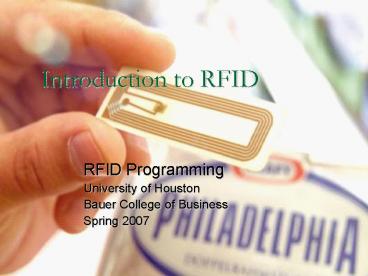Introduction to RFID
1 / 41
Title:
Introduction to RFID
Description:
RFID (Radio Frequency Identification) is a technology used for electronic and ... Applications: animal tracking, vehicle tracking, factory automation. 1970-1980 ... – PowerPoint PPT presentation
Number of Views:481
Avg rating:3.0/5.0
Title: Introduction to RFID
1
Introduction to RFID
- RFID Programming
- University of Houston
- Bauer College of Business
- Spring 2007
2
Some links
- www.rfidjournal.com
- www.computerworld.com
- www.rfidusa.com
- RFID Handbook
- www.uh.edu/gartner
3
Auto-ID Technologies
4
Definition
- RFID (Radio Frequency Identification) is a
technology used for electronic and wireless
identification of objects, humans and animals
5
RFID History
- People say the Internet happened quickly.
Theyre crazy. It took forever!
- Robert Taylor
- APRA IPTO Director
6
RFID History Ancient Times
Source AIM, Inc, 2001 (URL www.aimglobal.org/tec
hnologies/ rfid/resources/shrouds_of_time.pdf
7
Mandates
8
Mandates
9
Wal-Mart An update
- October 2005
- out of stocks reduced up to 16
- out of stock items with EPCs replenished 3 times
faster - stores with RFID 63 more effective in restocking
items - 10 less manual orders, reduced excess inventory
- helps make sure that promotional displays are
delivered and in place so that products are in
our stores and ready for sale when the
advertising begins - Shortens time for new items to make it to store
shelves - Aids in proof of delivery purchase order
reconciliation - provides product visibility
even after it has left receiving dock - gt 600 suppliers expected to be on board by 2007
10
11
RFID Principal System Components
- Tag (Transponder)
- Chip
- Antenna
- Reader (Interrogator)
- RF Module (Transmitter and Receiver)
- Control Unit
- Antenna
- Several Interfaces (RS 232, RS 485, etc.)
- Host Computer
- Middleware
12
RFID System Architecture
13
EPC RFID Architecture
14
EPC RFID System Architecture
15
Carrier Frequencies
- What is frequency?
- Refers to the property of radio waves used to
transmit data
16
Carrier Frequency
- RFID systems may use a particular frequency band
depending on - Application
- Legislature
- Cost considerations
17
Frequency Bands
18
Coupling
- 100kHz 30 MHz inductive coupling
- HF and Microwave systems use electromagnetic
coupling
19
Coupling
20
Frequency and bandwidth
- Frequency is of primary importance when
determining data transfer rates (bandwidth) - The higher the frequency, the higher the data
transfer rate
21
Range
- Range the working distance between a tag and a
reader
Range
22
Range and Power Levels
- The range that can be achieved in an RFID system
is determined by - The power available at the reader
- The power available within the tag
- The environmental conditions and structures
- More important at higher frequencies than at
lower frequencies - 100-500mW
23
Material Propagation
- The absorption rate for water and other
non-conductive substances is lower by a factor of
100 000 at 100 kHz than it is at 1 GHz - LF systems are primarily used due to their high
propagation of substances
24
Electromagnetic Interference
- Electromagnetic Interference - Interference
caused when the radio waves of one device distort
the waves of another. Cells phones, wireless
computers and even robots in factories can
produce radio waves that interfere with RFID
tags. - EI is likely to be an issue for UHF systems
25
Tags Characteristics
- Means by which transponder is powered
- Data carrying options
- Data read rates
- Programming options
- Physical forms
- Costs
26
Active and Passive Tags
- Active tags
- Powered by an internal battery
- Finite lifetime (because of battery)
- Greater range
- Better noise immunity
- Higher data transmission rates
27
Active and Passive Tags
- Passive tags
- Operate without battery
- Derive power from the field generate by the
reader - Less expensive
- Unlimited life
- Subject to noise
- Require more powerful readers
- Orientation sensitivity
28
Data Carrying Options
- A tag can contain
- An identifier
- 1bit 128 bits
- Portable data files
- Example 64 K
29
Data Read Rate
- Data read rate is linked to frequency
- The higher the frequency, the higher the read rate
30
Data Programming Options
- Read-only
- Cheap
- Write once read many (WORM)
- Read/write
- Expensive
31
Why Use Read/Write Tags?
- Greater flexibility
- Customers may change requirements
- Standards may change
- Database dependence
- Ownership issues
- Lag times
- High risk applications
32
Tag Physical Forms
- Disk and Coins can be attached to an item by a
fastening screw
33
Tag Physical Forms
- Mount-on-Metal special construction minimizes
impact of metal in terms of interference
34
Tag Physical Forms
- Keys or Key Fobs, Watches access control
35
Smart Labels
- A bar code can be printed on an RFID label
36
Tag Physical Forms
- Glass Transponders can be implanted under skin
37
Whats so special about RFID?
- Unifying Auto-ID technology
- Line of sight is not required
- Longer read ranges
- Faster hundreds of items can be scanned in one
read
38
RFID vs. Barcodes
39
RFID Evolution (Gartner, 2003)
40
RFID Growth
- Several market research firms predict that 2007
RFID market will reach 3 billion
41
- Questions?































